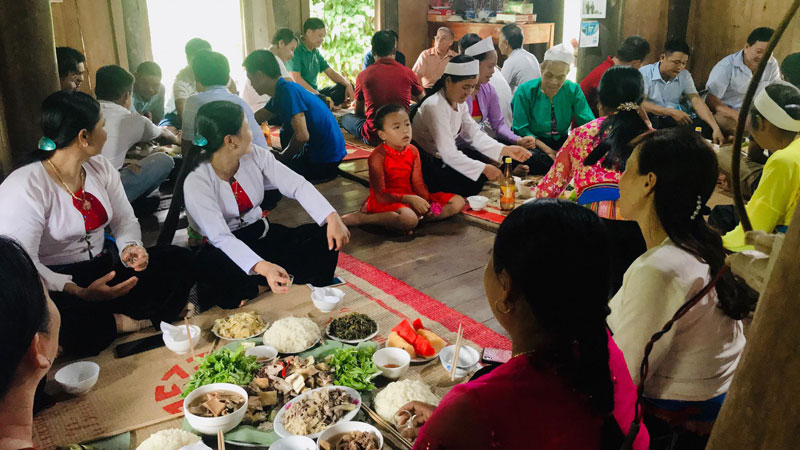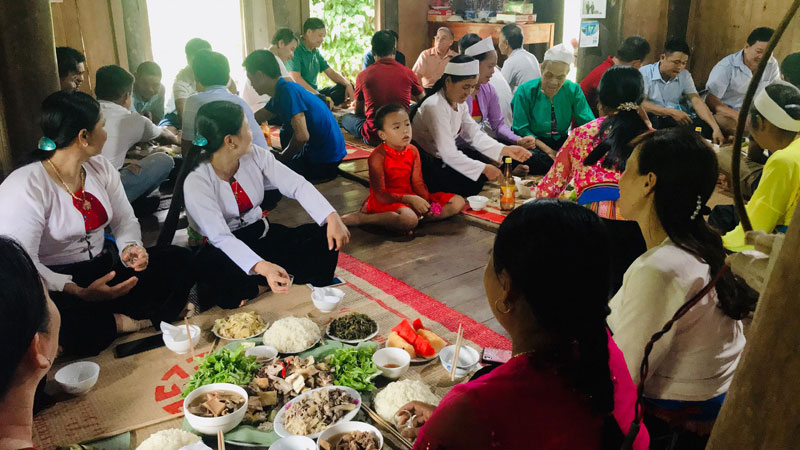
(HBO) - Under the leadership of the Party, in August 1945, people nationwide participated in the general uprising to seize administration and put an end to slavery, thus opening up a new era of independence and freedom.
joining people across
the country in celebration of the August Revolution victory, Lac Son district’s
authorities and people organised the first "Tet Doc Lap” (Independence Festival)
in 1945. Since then, on the occasion of the National Day (September 2) every
year, locals joyfully celebrate Tet Doc Lap, which is the Muong ethnic group’s
second biggest festival in a year after the lunar New Year.
 Locals in Vo Giua hamlet, Nhan
Nghia commune (Lac Son) gather to have Tet Doc Lap banquet.
Locals in Vo Giua hamlet, Nhan
Nghia commune (Lac Son) gather to have Tet Doc Lap banquet.
It has become a custom
of Muong ethnic people in Muong Be hamlet of Chi Dao commune to celebrate the Tet
Doc Lap on the National Day. In the village, all households prepare wine, pork,
poultry meat and new rice for the occasion, and houses and roads are cleaned up
and decorated.
Visiting any Muong
ethnic-inhabited areas in Lac Son district, especially Muong Vang and Muong
Khoi, visitors will have a chance to enjoy the festive atmosphere. All roads
are decorated with posters and flags and many activities are organised. This year, the joy of
Lac Son locals seems to double thanks to positive socio-economic development
results of the district. The locality aims to
turn the event into a special cultural-tourism product – a symbol of locals’
pride.
This year, Nhan Nghia
commune was selected to hold a model Tet Doc Lap. Activities include a ceremony
to pay tribute to heroes and martyrs at the local monument with a speech on the
history of the August Revolution general uprising, along with art performances,
folk games, a cuisine contest and a competition between traditional trade
villages./.
With an increasingly vibrant and widespread emulation movement aimed at building cultured residential areas and cultured families, Yen Thuy District has been making steady progress toward improving both the material and spiritual well-being of its people, while fostering a civilized, prosperous, beautiful, and progressive community.
Once lacking recreational spaces and community facilities, Residential Group 2 in Quynh Lam Ward (Hoa Binh City) has recently received attention for the construction of a new, spacious, and fully equipped cultural house. The project followed the model of state support combined with public contributions in both labor and funding.
The "All people unite to build cultural life" movement, which has been effectively integrated with Kim Boi district’s socio-economic development goals, is fostering a lively spirit of emulation across local residential areas, hamlets, villages, public agencies, and enterprises. In addition, through the initiative, traditional cultural values are being preserved and promoted, while community solidarity and mutual support in poverty reduction and economic development are being strengthened.
A working delegation of the Hoa Binh provincial People’s Committee led by its Permanent Vice Chairman Nguyen Van Toan on June 11 inspected the progress of a project to build the Mo Muong Cultural Heritage Conservation Space linked to tourism services in Hop Phong commune, Cao Phong district.
Born and growing in the heroic land of Muong Dong, Dinh Thi Kieu Dung, a resident in Bo town of Kim Boi district, in her childhood was nurtured by the sweet lullabies of her grandmother and mother. These melodies deeply imprinted on her soul, becoming an inseparable part of her love for her ethnic group's culture. For over 20 years, this love for her hometown has driven Dung to research, collect, and pass down the cultural values of the Muong people to future generations.
In the final days of May, the Ethnic Art Troupe of Hoa Binh Province organized performances to serve the people in remote, mountainous, and particularly disadvantaged areas within the province. These were not just ordinary artistic shows, but they were the meaningful journeys aimed at spreading cultural values, enhancing the spiritual life of the people and contributing to the preservation of ethnic minority cultural identities.



 Locals in Vo Giua hamlet, Nhan
Nghia commune (Lac Son) gather to have Tet Doc Lap banquet.
Locals in Vo Giua hamlet, Nhan
Nghia commune (Lac Son) gather to have Tet Doc Lap banquet.